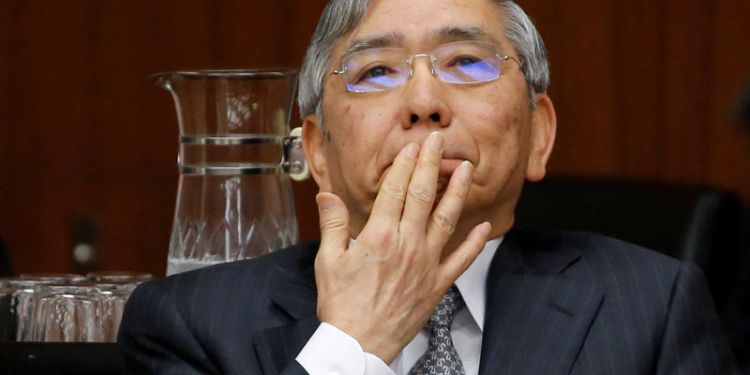 © Reuters. BOJ Governor Kuroda attends a financial and monetary committee session at the Lower House of the parliament in Tokyo
© Reuters. BOJ Governor Kuroda attends a financial and monetary committee session at the Lower House of the parliament in TokyoBy Leika Kihara
TOKYO (Reuters) – Bank of Japan Governor Haruhiko Kuroda may have little to cheer about despite landing another five-year term for one of the most influential jobs in the country, if not the world.
For one thing, the 73-year-old Kuroda faces a grueling job: frequent overseas trips and grillings in parliament some 50 times a year by lawmakers who summon him usually on short notice.
The number of appearances – 10 times that of the Federal Reserve chair and seven times that of the Bank of England governor – could drain even a workaholic like Kuroda, who is in good health. He will turn 78 if he serves until the end of his second term through April 2023, making him the longest serving governor in the BOJ’s 135-year history.
Age, however, could be the least of many challenges the bookish Kuroda faces in his second term, as his quantitative easing (QE) experiment becomes prolonged.
His biggest task ahead will be to engineer a smooth exit from crisis-mode stimulus, now that the economy is stabilizing – and to signal how that will be done without throwing markets into turmoil. On the other hand, if the economy slips back into the doldrums, Kuroda has a diminished capacity to relaunch a stimulus program after the massive asset purchases of the past five years.
“Kuroda’s bazooka stimulus was intended to be a quick-fix solution to deflation,” said Izuru Kato, chief economist at Totan Research. “But it’s still around and causing problems that have become hard to dismiss, mostly in the banking sector.”
Graphic on deflation http://tmsnrt.rs/2o1ZxRk
Years of near-zero rates are straining the banking sector, with more than half of Japan’s regional banks having lost money on their core business in the year ended March 2017.
DEFLATIONARY MINDSET
Five years ago, Kuroda’s job was to shock the public out of a deflationary mindset with a blast of QE and revive a stagnant economy hurt by a strong yen.
He used skills, honed when he was Japan’s top currency diplomat overseeing exchange-rate intervention, to stun markets by scale and timing to maximize the policy effect.
Now, the problem has become more complex. Inflation remains distant from his 2 percent target even as the economy enjoys its longest streak of expansion in four decades, forcing the BOJ to keep expanding its balance sheet at a pace deemed unsustainable.
Kuroda’s unprecedented QE experiment has scooped up 40 percent of Japanese government bonds and bloated the BOJ’s balance sheet with risky assets like exchange-traded stock funds. The rising cost of that has become a matter of intensifying debate among BOJ policymakers.
Winding down the stimulus program requires deft communications to avoid surprising markets. Telegraphing an exit is never easy, as illustrated when U.S. yields spiked in 2013 after former Fed chairman Ben Bernanke signaled a slowdown in asset purchases.
The BOJ itself was caught off guard when a cut to its regular bond purchases in January spooked investors who pushed up yields and the yen.
“It’s very hard for any central bank to fully convey its intentions to markets,” said Kazuo Momma, a former BOJ executive who oversaw its international and monetary policy affairs.
“The risk of miscommunication is always there, especially when central banks are shifting policy. It’s a risk inherent to central bank communication.”
TIES WITH ABE
Signaling an exit could also create rifts in Kuroda’s cozy relations with Prime Minister Shinzo Abe, who has won elections and enjoyed solid ratings for keeping the economy afloat.
Abe instructed his ministers on Tuesday to come up with spending measures to ease an expected hit to private consumption from a scheduled sales tax hike next year.
Pressure from Abe’s administration to keep borrowing costs low could discourage the BOJ from signaling an exit. The recent stock market rout could also prevent policymakers from debating an exit, if a rising yen begins to hurt corporate profits and exports.
“The BOJ should be dialing back stimulus to prepare tools to deal with the next recession, which could come around 2019,” said former BOJ board member Sayuri Shirai. “The best chance to do this was last year. With that opportunity missed, the BOJ won’t be able to move for quite a long time,” she told Reuters.
In the worst case scenario, Kuroda may be forced to expand, not dial back, stimulus to fend off external shocks like a strong yen – with little means to do so.
After five years of buying, the BOJ’s government bond holdings rose by three-fold to 445 trillion yen ($4.2 trillion) – roughly 80 percent the size of Japan’s economy – leaving little room to ramp up buying.
Lowering interest rates could also prove counter-productive as it would narrow margins at financial institutions and risks destabilizing the banking system, analysts say.
“The BOJ is already doing the maximum in terms of easing,” said Momma, the former BOJ executive. “That means there’s no additional means left that are feasible and effective.”
Source: Investing.com























